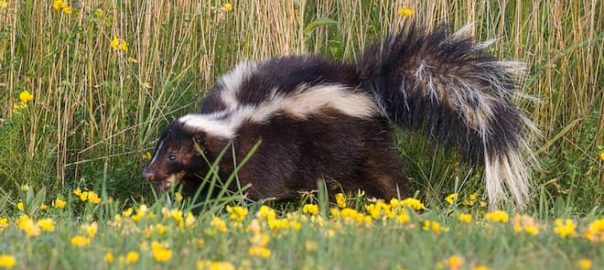Skunk Trapping Tips – Should You Do it Yourself

Skunks can wreck havoc on your property whether it is digging holes in your yard or destroying your deck or shed at the entry point. The biggest problem for homeowners however is the skunk odor. Small children and pets are most vulnerable to getting sprayed although adults are equally at risk. Trapping is one of the most commonly used methods for skunk removal and a few tips may be helpful should you choose to do the skunk removal yourself.
- Get a large cage trap. A raccoon sized trap; about 30 inches long by 12 inches high by 10 inches wide is the best option. You may want to buy a brand name trap that has a track record of catching wildlife successfully.
- The best bait for skunks is meat-based bait such as cat food. The problem is you might catch stray cats or pets so it best to stick with marshmallows which rarely attract other animals besides skunks. If you are absolutely sure that cats won’t be a problem, you may use cat food.
- Place the trap where you have seen skunk activity or around where you suspect the skunks live. Possible areas include near decks, sheds and porches. Make sure that the trap is flat on the ground and sturdy so it won’t tip over.
- Once you have caught the skunk, approach the trap with caution. Hold an old blanket, bed sheet, cloth or towel wide in front of you and approach gently. Drape the cover over the trap and wait until the skunk calms down before transporting the cage.
Why You Shouldn’t Trap Skunks
Trapping skunks seems like the sensible thing to do but this removal method isn’t as easy or humane as most people think.
Trapping the skunk during baby season leaves the young animals to die of starvation. You first need to make sure that there are not babies involved before undertaking removal. These animals tuck away their young in tight spaces underneath the deck or other structure so you need to check thoroughly before concluding there are no babies.
Keep in mind that it is illegal to transport trapped wildlife in Canada for more than 1 kilometer without a permit. Releasing skunks within close proximity to your property means they can find their way back especially if you haven’t removed what attracted them in the first place.
There is also always the risk of getting sprayed or attacked by a rabid skunk. Rabid skunks carry rabies.
The best solution is to hire a wildlife removal company in Canada to remove the skunks. The service includes removing kits, humane eviction, bio-cleaning the nest to prevent other wildlife from occupying the empty nest, sealing all potential entry points with galvanized steel mesh, repairing damaged caused by skunks and more.
Successful skunk removal is a long, detailed process and it is very unlikely that you will succeed on your own. Hire a wildlife control company that offers a warranty for the removal for at least two years. Call Wildlife Shield now: 647-560-3988.